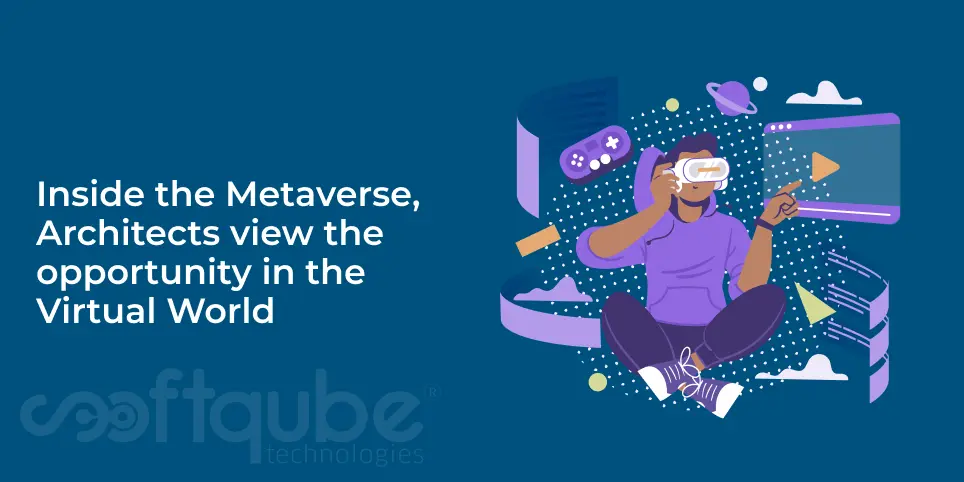Inside the Metaverse, Architects view the opportunity in the Virtual World
August 22, 2022

Table of Contents
- Everything you need to know regarding Metaverse Architecture
- Contribution of Metaverse Architects
- importance of social responsibility in this virtual world
- Metamodernism architecture
- Meta city
- Metarchitect Studio
- Vault Hill Office
- The fever of NFT and the Design Profession’s future
- The Metaverse’s Designers
- Socio-cultural integration
- The Metaverse vs. Existing architecture
- Companies Designing in The Virtual World
- Wrapping Up
Let us all admit that we are curious about the Metaverse and the future it offers for pursuing the buzz created after Mark Zuckerberg publicized it in October’21. But did you think about how the Metaverse’s distinct aspects are penetrating the field of design and architecture? Metaverse is a virtual online world that integrates 3D holographic avatars, virtual reality, augmented reality, and other types of communications. The users in the Metaverse stay in the digital realm and engage with each other using virtual reality technologies and avatars. This technology enables people to live in the parallel liver while adopting unique digitalized avatars.
Everything you need to know regarding Metaverse Architecture
The digital economy is at its peak
The world economy is substantially transitioning from the physical world to the virtual one. Since the world epidemic, the merger of both the worlds has significantly grown. Various real retail shops have shut while fashion labels like Balenciaga have planned to display their present collection through a video game. Commercial property owners are under pressure because tenants reduce or quit their operations, and video conferencing such as Zoom has been growing in popularity. The total working environment has changed because of the pandemic, be it the operation of the organizations or e-commerce. All is changed. In the crypto, fashion, and gaming industry Metaverse has been laying its stepping stones. Post this, in the architecture world, Metaverse is trying to make its mark.
Metaverse architects serve as a support system between both the real and digital worlds
Architects have been responsible for designing theaters, malls, buildings, etc., for centuries. The team understands the details of the projects that they are working on. With their combined efforts, fruitful results are delivered to the end-users. You may be wondering, in the Metaverse, how this coordination is possible. With digital twins in the Architectural Engineering and Construction (AEC) industry, architects can act as the bridge between both worlds. With the use of simulations in the “test drive” of unassembled buildings, architects can create virtual copies of the events of the real world.
We cannot deny that architects significantly contribute to the fulfillment of the imaginative projects of the Metaverse. In the Metaverse, people need places, so designers and architects are required to create or enhance these spaces. However, we consider architects will probably change with this new world’s expansion. In the Metaverse, architects must integrate professional knowledge in various fields, including game design, character design, content design, and user interface, and also need to prepare the 3D modeling. A digital twin imitates the building, which narrates a story using data from the linked sensors all over its life cycle.
A comprehensive range of programmers and game designers might become architectural design teams. In the process of this innovative age of architectural design, more people will be participating in the process. Additionally, architectural education will require teaching a combination of 3D technology and digital media to the new phase of architects. This will shift outside the history of materials, construction techniques, and architecture. Moreover, the Metaverse may be an innovative frontier in architectural conservation. Metaverse can act as a platform whereby we preserve buildings inside the digital reality for future generations. With apps such as photogrammetry and point clouds, it is quite possible to hold digital clones and scan data in the Metaverse. You must use your creative ability to build experiences and interactions in the virtual world.
What is the importance of social responsibility in this virtual world?
Architects are excellent listeners as well as speakers. They start by carefully listening to understand what our communities and customers want. Not only do they try to satisfy the customers, but they also lay a huge emphasis on the social impact their work creates in serving the total community better. We find the architects where the culture emerges as well as expresses itself. It focuses on holding a unique cultural backdrop before the conceptual design, which includes lifestyles, location memories, and languages. On the Metaverse, there do not exist any geographical restrictions. The users of the metaverse world come from diverse cultural and social backgrounds. In this way, one can develop vernacular metaverses having variable cultures.
Metamodernism architecture
The architecture of Metamodernism is an architectural movement and philosophy built on state-of-the-art technology of virtual architectural design in various metaverses. The architecture of Metamodernism is, most importantly, an architectural trend. It is a movement that is devoted to distributing their expressions all over many metaverses with particular intriguing ties to the Decentraland, like holding a PolkaWorld event. Yen and Charlie Sun are the architects who are at the forefront of the movement of Architecture. The founder of the Meta Live Studio, Charlie Sun, has been a designer and an architect for 10 years. Yen is another metaverse architect who started her journey in the year 2019. She has been working for famous artists such as The Shanghai Gallery and ArtGee.
Meta city
With the increasing structures, events, and users, the team is pretty confident regarding the future of Decentraland. As urban planners and experienced architects, they have made a simulation of the metropolis of Metaverse for the upcoming few years.
Metarchitect Studio
The studio of the metaverse architecture uses the idea of a floating digital unit Genesis voxel that develops innovative architecture on the go. This is a representation of the Metaverse spirits, a manifesto for Metarchitects, and a gallery of the language of the Metaverse architecture where you can explore the different architectural forms of the Metaverse.
Vault Hill Office
A Vault Hill Office is the Metaverse inside a Metaverse. You can think of it as the experimental hub for the Decentraland metaverse. This idea aims at combining real-life design with the function by combining the real-life design with the function with the incorporation of conventional architecture design into the Metaverse. This consists of three levels. At first, we have a public atrium. Next, there is a private space, and last, is the rooftop having a mesmerizing view of the surroundings.
The fever of NFT and the Design Profession’s future
If you were offered a virtual reality building, would you purchase that? Nothing can be entered into the real world but a video or a picture you may see. Basically, this is what is backed when architecture enters the realm of NFTs (Non-Fungible Tokens) that have now taken over the world.
Since 2013, NFTs have been around, but suddenly their popularity has skyrocketed or captured the mainstream media’s attention. Because of the disruption, novelty, and excitement over digital transactions, the bidders are interested in possessing a piece of virtual uniqueness. NFTs have been designed to deliver you something unique, the ownership of the work that is valued at a cost that you are paying for it through blockchain. It has been viewed as the upcoming step in collecting fine art and an innovative frontier in terms of what we consider art, how we present it, and how we value it.
A digital file might be copied the number of times you wish, but there is always one unique. It is very similar to how Mona Lisa is represented at the Louvre, the sole picture that has been globally copied. The success of NFTs has been because of technological advancements that have created an environment where goods can be acquired. To construct a digital replica of the real world is similar to founding an alternative universe for the architects- an unexplored area of possibilities having no limits. In the Metaverse, the great unfathomed requirement for material can surge in the field of digital architecture for developing virtual venues like museums, conference rooms, stadiums, or even a total city.
The Metaverse’s Designers
A vital question that comes to mind is whether the virtual world is similar to the physical one. The good design of today is aesthetically pleasing to one’s eye, simple to use, intuitive, and, it is an absolutely immersive experience. Individual involvement while pursuing an objective in the Metaverse might be very vital than the speed by which it reaches its objectives in the real world. It is quite desirable to visit the marketplace instead of accessing the online markets. You can buy anything anytime, or a person might wish to visit friends instead of meeting them via Zoom sessions. Anyone having a wild and creative imagination can readily view the Metaverse’s creation. But as the designers of the real world, what do the real world’s architects bring to the table?
Socio-cultural integration
Though there are no physical limits in the world of the Metaverse, some sociological problems might persist. In the virtual world, to shape a healthy society, designers have to understand in the actual world how societies run, and their understanding of the cultural and social issues is unparalleled. As a result, the architect’s job is to guarantee that the Metaverse is a vernacular and inclusive environment.
Psychology and Environment
We all are aware of the truth that our surroundings influence our emotions. Spaces can make us feel energized, depressed, sad, and joyful, and an excellent design is known to have purpose and emotion. The Metaverse will require designers who have a better understanding of this which is impossible without the architects. The architects are quite curious as well as understanding listeners. They comprehend community desires and needs and human psychology, then apply this knowledge to a constructed environment.
The Metaverse vs. Existing architecture
There are differences between authentic architecture and a metaverse. The most prominent difference is the features of the space itself. Whether you interact with a space or not, it does exist in the natural environment. However, in a virtual environment, every place has a story or a reason. Additionally, no real-life restrictions or rules like physical laws, climatic issues, structural stability, or gravity will bring something to the metauniverse. So, the architects have the freedom to overcome the prevailing conditions and create authentic pieces of art and exceptional environments.
On the other hand, in the metaverse architecture, not every five senses are included. Thus, the atmosphere is delivered with limited resources, and audio and visual effects are emphasized more. In the prevailing architecture, before the constructions, visualizations are developed for delivering the details and atmosphere of the space to the audience. The whole environment is built in the Metaverse with a similar amount of effort and time spent solely on visualization.
Companies designing in the virtual world
Architects from Decentraland
The blockchain of the virtual reality world is referred to as Decentraland Architects, which was founded in March 2021. The customers provide architecture and 3D design to develop and build professional virtual real estate. The users can use Mana, the in-game cryptocurrency, to purchase plots of land and parcels and spend their time in an immersive environment.
ILLUSORR
A design-oriented metaverse that merges the virtual and physical worlds to develop original experiences and environments is referred to as ILLUSORR. It focuses on redefining the virtual reality business once fragmented as an all-in-one platform that delivers individuals, creatives, and corporations with a totally immersive metaverse experience.
Architect Zaha Hadid
Recently, Zaha Hadid architects have collaborated with PUBG to create a virtual environment whereby worldwide players can experience an interactive environment. This is a realm where around 100 individuals in a technically and aesthetically rich battleground defeat other players.
Wrapping up
After considering everything, we view our future home metaverse as mostly determined by how efficiently the places have been constructed. As a result of which, architects will be at the frontline of Metaverse by providing highly desired three-dimensional attributes to millions of users. In spite of being computerized, the buildings of the Metaverse have been designed with a similar inspiration as conventional architecture. As the architectural environment and world evolve around us, more architects and designers will pursue possibilities in building digital assets and virtual landscapes with the same forethought, vision, and passion that we view in the designs surrounding us on the planet.

Hari Patel
I am the Managing Director of Softqube Technologies Pvt. Ltd., a modern-day digital transformation, design and development service provider. We provide services to businesses of all verticals across the globe. I believe and live by a mission that I help more entrepreneurs to build, launch and grow profitable businesses.
share your project details
"*" indicates required fields
Global Presence

Georgetown TX-78626

Lansdale, PA-19446

Ahmedabad, GJ-382350

Melbourne

Windhoek
Skype


